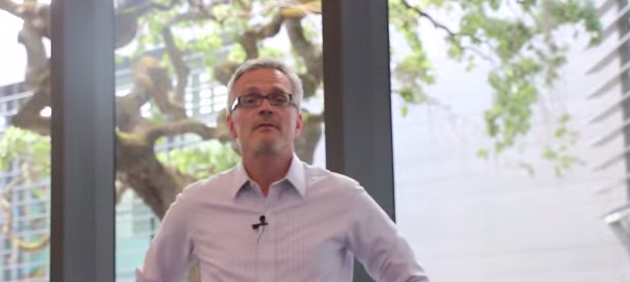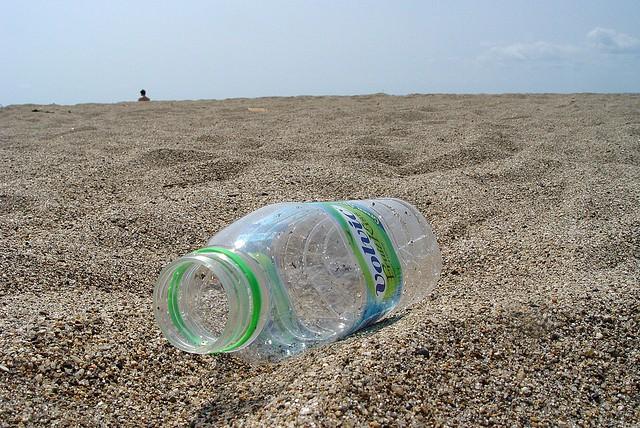Sustainability & Innovation: Chris Librie, HP Living Progress


At this year's Sustainable Brands conference in San Diego, we were challenged by Janssen Pharmaceuticals to ask leaders at the conference what the word "innovation" meant to them. Then, more specifically, we asked how innovation may or may not drive advancements in sustainability. We got a terrific range of responses, which we've got documented in a series of short video interviews. You can follow along here.
In this interview, Chris Librie, senior director of HP Living Progress, gives his answers:
3p Weekend: 12 Offbeat Companies for the Conscious Traveler


With a busy week behind you and the weekend within reach, there’s no shame in taking things a bit easy on Friday afternoon. With this in mind, every Friday TriplePundit will give you a fun, easy read on a topic you care about. So, take a break from those endless email threads and spend five minutes catching up on the latest trends in sustainability and business.
Love to travel but hate the impact? You're not alone. After all, what's the point of going to a new place if you lay your head at a chain hotel, spend your days in crowded tour groups with other Americans and create little more than waste for the community you visit?
Luckily for the conscious and curious travelers out there, you can have the best of both worlds. This week we tip our hats to 12 offbeat tour companies that are perfect for the low-impact traveler. So, give it a read, and go out there and see something!
1. Alianza Mesoamericana de Ecoturismo (Mesoamerican Ecotourism Alliance)
This nonprofit sustainable tourism alliance weaves conservation into every trip. It starts by identifying conservation potential and desire for tourism in a mostly unexplored corner of Mesoamerica. The alliance then works to establish infrastructure, which not only serves tourists, but also the local community.
Working with local operators, the alliance helps communities bring their offerings to market. It currently offers tours in Mexico, Belize, Guatemala, Honduras, El Salvador, Nicaragua and Panama, ranging from developed to pristine environments.
2. Myths & Mountains
Established in 1988, Myths & Mountains provides cultural tours in Asia and South America. You can also travel with a purpose through its READ trips. "We wanted to give something back to the people who let us inside their homes," company president, Dr. Antonia Neubauer, told TriplePundit at the AdventureElevate conference in Colorado last week.
For every trip taken to Bhutan, India and Nepal, Myths & Mountains provides a donation to READ Global, a separate 501(c) nonprofit entity founded by Neubauer, to fund the construction of libraries and community centers for rural villagers. The nonprofit seeds for-profit businesses to make each library self-sustaining and "connect centers with other organizations providing such diverse resources as microcredit, women’s empowerment, literacy training and health care." To date, READ has established over 107 enterprises supporting almost 80 READ Centers serving almost 2 million rural villagers.
3. World Nomads
Insurance is a good idea for any adventure traveler. With insurance provider World Nomads, a portion of the price of insurance goes toward community development projects around the world.
Formed 10 years ago, World Nomads' Footprints program was established to help travelers make a difference through small donations to specific community projects. From free eye care to school tuition, these poverty alleviation projects "bring life and color" to the communities in which World Nomads operates, said Christina Tunnah, the company's regional manager for the Americas.
Users can also track their donation online, and each donor receives an email when their project is complete. The program has proven to be an overwhelming success: Last month, Footprints surpassed its millionth donor -- representing $2.4 million in funds raised and life-changing projects for more than 850,500 people.
4. Context Travel
Lifelong traveler Paul Bennett started Context Travel 12 years ago on a trip to Rome -- a city that, as he puts it, suffers from "an epidemic of mass tourism."
As an antidote to snooze-worthy tour groups and sweaty crowds, Context Travel brings intellectually-curious travelers together with local academics in more than 35 cities for offbeat and culturally vibrant tours.
If learning about the sites from a doctorate-level docent -- rather than a bored tour guide -- isn't awesome enough for you, Context is a fellow B Corp and donates a percentage of its profits to the Context Foundation for Sustainable Travel, a U.S.-based nonprofit that invests in projects that mitigate the impact of tourism on the seven cities where the company operates.
5. Untours
This B Corp travel company lives up to its name: No fancy-dancy hotels and overcrowded tour groups here. The 38-year-old company offers apartment-based independent vacation packages in Europe, bringing travelers together with locals for a truly unique experience.
Untours is also carbon neutral and donates nearly 100 percent of its profits to sustainability and poverty alleviation projects through the Untours Foundation.
6. Wilderness Travel
Wilderness Travel hosts low-impact adventure trips around the world and donates a portion of the proceeds to a conservation fund.From bringing education to Nepalese Sherpa communities to conserving wilderness that's home to big cats and rhinos, the donation that accompanies your exotic treks makes a difference for thousands around the world.
7. Firefly Journeys
If you're looking to travel abroad, it can often seem tough to work with an in-country tour operator. Sure, you want your dollar to support the local community. But there's often a language barrier, and it can be stressful to send credit card information over the phone. Enter Firefly Journeys, which serves as U.S. sales office that connects Western travelers to in-country operators around the world.
Looking to make a difference when you travel? Firefly Journeys has just the ticket. Its latest voluntourism offering, Ace the Himalayas, allows visitors to help Nepalese communities recover from earthquake damage by rebuilding homes. At $1,199, the 13-day trek is both affordable and impactful: Travelers will enjoy the beauty of Nepal while spending three days helping villagers rebuild, and $200 of the trip price pays for building supplies.
8. Rios Tropicales
Enjoy ecotourism in Costa Rica while supporting reforestation and educational programs? Sounds like a win-win to us.
Established in 1985 and celebrating its 30th anniversary, Rios Tropicales offers whitewater rafting, biking, kayaking and more, but that's far from its only mission. In 1989, the company purchased 90 acres of rainforest along the Pacuare River near a small subsistence farming community. The previous owner planned to convert the area to farmland to feed his family, but Rios hired him to kickstart a restoration project instead. Since then, the company has purchased and restored 2,000 acres of Costa Rican rainforest in collaboration with travelers and local communities -- you can even plant a tree on your visit!
The company's roots in the community are deep: It employs 95 percent local staff and offers higher-education opportunities for its trekkers and guides. Not enough green for you? Rios is also carbon neutral, powers its operations with a hydropower plant and was one of the first tour companies of its kind to take up composting.
9. EcoVentura
Established in 1990, EcoVentura leads the way in expedition cruising in the Galapagos Islands. Due to the delicate nature of the Galapagos ecosystem, it's only natural that the company's roots are built on a foundation of sustainability.
In 2006, EcoVentura and the World Wildlife Fund teamed up to create the Galapagos Marine Biodiversity Fund, aimed at helping local communities manage natural resources through environmental education and marine conservation. It also provides ecology-related scholarships under the auspices of Ecology Project International, a nonprofit NGO, and has earned numerous accolades for its sustainability programs. The company also invites visitors to pack with a purpose by carrying 5 pounds of necessary supplies to donate to communities that need it.
3p founder Nick Aster took an EcoVentura trip to the Galapagos earlier this year. Click here to learn more about the experience (and check out his antics with giant tortoises).
10. Frontiers North Adventures
Frontiers North Adventures offers wildlife and nature travel in Northern Canada with a portion of the proceeds going toward conservation.The company is also committed to invest in the communities in which it operates: It hires locally, buys locally and supports local causes.
11. Say Hueque
Want to get off the beaten path? Look no further. The No. 1 tour operator in Argentina, Say Hueque will connect you with a local guide and a custom-made itinerary through its TEEM Project.
The company also supports education and development in local communities through donations and employee volunteering.
12. REI Adventures
REI Adventures is known for its killer adventure trips, but did you know it also provides volunteer vacations?The company teamed up with Conservation Volunteers International Program — a nonprofit dedicated to conserving iconic wilderness areas and cultural sites around the world — to make a difference with its trips.
Volunteers work alongside expedition leaders and local park rangers to do things like trail maintenance, restoration of wildlife habitat and collection of native plant seeds. Choose from five destinations: Galapagos, Machu Picchu, Torres del Paine, Virgin Islands and Yosemite.
Image credit: Flickr/David Berkowitz
How Nike Embraced CSR and Went From Villain to Hero


This article is part of a series on “The ROI of Sustainability,” written with the support of MeterHero.
It was only 20 years ago that consumers were protesting outside Niketown stores, and news stories were casting Nike in the role of villain amid child labor and sweatshop allegations. It’s hard to believe, given the steady stream of corporate social responsibility (CSR) accolades the company has racked up in the last 10 years, that Nike was facing boycotts and public ire throughout the 1990s.
In 1998, then-CEO Phil Knight made a public speech promising change. The company struggled to put new policies in place and enforce them.
In 2005, Nike was the first company in its industry to demonstrate transparency, when it published a complete list of its contract factories. In the same year, it also published its first version of a CSR report -- detailing pay scales and working conditions in its factories and admitting continued problems.
The tide turned once the company acknowledged its issues, demonstrated transparency and worked toward change. And today the company is counted among CSR leaders.
The business case: Turning PR woes into brand value
In its latest CSR report (2012-2013), Nike demonstrates its evolved worldview.
“Indeed, creating and building business models that not only recognize and accommodate, but thrive also on, the constraints of the natural world is the only way we can achieve growth in the present that won’t compromise our ability to grow and succeed for decades to come.
"Transforming Nike in this way will take time and is a long-term commitment," the report went on. "It touches every aspect of our business, from how we design and make our products to how we engage our employees and other businesses in our value chain ...
"We ask difficult questions of ourselves, our business model and our industry. Rather than working to avoid only known risk, we work to understand where risks and opportunities may emerge as well as what’s needed to address them and enable new forms of innovation to take hold.”
As of the end of fiscal year 2013, the report counted over a million workers in 785 contract factories and a total of 2.5 million people across Nike's value chain. The company has implemented policies supporting workers, demanded their contractors and suppliers meet them, and conducted third-party audits.
The intentional moves toward change proved successful: In 2013, auditors found violations in 16 percent percent of factories (down from 29 percent in 2012). Incidences of excessive overtime went down to 55 (from 116 in 2012), and 93 percent of factories reported no incidences (up from 87 percent in 2012).
After the tragic Rana Plaza factory collapse, the poor working conditions still found in the garment industry were brought under international scrutiny. By then, Nike CSR lead Hannah Jones was already advocating against manufacturing in Bangladesh, and had been doing so for years. But the tug-of-war over mandating good working conditions and the need to cut costs drove Jones and her colleagues to visit Lyric, a 10-year Nike supplier. The working conditions Jones described to the Wall Street Journal were so appalling, Nike cut ties with the company afterward, shortly before the Rana Plaza disaster.
Nike also worked with its contract facilities to improve its human resources and implement lean practices. Far from its exploitative practices in the 1990s, the company now says:
“We believe that a valued contract factory workforce means better business for the factories and for Nike, and better well-being for individual workers. Factories that value their workers ... can build a skilled, productive and engaged workforce.”
Improving the supply chain: Focus on water
In addition to continuing to work on improving conditions for workers, Nike is innovating its materials development and management to address the impact of climate change on the supply chain and reduce its environmental impact. One area of concentration is water conservation.
Nike made this statement to TriplePundit:
"We are making progress in assessing and understanding our overall water footprint, which helps us identify opportunities for conservation across our value chain. Though we have targeted water efficiency improvements for manufacturing and materials processing, we recognize that efficiency is not the only relevant measure."Water quality, water security and access to water and sanitation also impact our supply chain and our business, affecting everything from the availability of raw materials to the health and well-being of workers and their communities."
In 2012, Nike partnered with DyeCoo Textile Systems, a Dutch startup, and adopted their new carbon-based dyeing process that dyes garments without using water or chemicals. Without water, the process also reduces its energy use by 60 percent since the garment doesn't have to be dried. It also dyes 40 percent faster.
The savings are significant. The previous process required 25 to 40 gallons of water for every 2 pounds of textiles dyed. Until this process, Nike's contracted textile plants used approximately 3 billion gallons of water a year, and Nike itself used 325 million gallons. In 2013, Nike announced the first water-free dyeing facility in its supply chain at a Taiwanese contract manufacturer, Far Eastern New Century Corp., and unveiled the name of the sustainable innovation -- ColorDry -- to highlight the environmental benefits and intense coloring achieved with the technology.
In addition, Nike has pledged that it will eliminate hazardous chemicals from its global supply chain by 2020.
Transparency: The problem isn't accusations, but how a brand responds to them
After all this progress, Nike’s star has been soaring. However, recent allegations of shady business dealings (also during the 1990s) announced in the beginning stages of an extensive FIFA investigation are threatening to stain the sportwear giant’s brand once again.
Rick Burton, the former head of the University of Oregon’s Warsaw Sports Marketing Center, who worked closely with Nike as it expanded its business in China, told the Guardian, "the real challenge for Nike may not be the accusations but how it responds to them."
The tide turned in 1998 when the company faced its problems head on. It has built up a lot of goodwill with its actions since. As this investigation continues and the topic resurfaces in the news, it will be interesting to see if the company's solid reputation gives it the benefit of the doubt in consumers' minds, and if the company, once again, will rely on honesty and transparency to regain consumer trust.
As for Nike, the company remains optimistic and focused on the future and their sustainability goals. The company told 3p:
"For Nike, there is no finish line when it comes to finding the best solutions for athletes, the business and the planet. As a company committed to sustainable innovation, exploration of advanced innovations like ColorDry continues to be part of Nike’s effort to reduce dependency on constrained natural resources. We are excited by the progress being made and remain committed to the objectives of scale and industry-wide transformation."
For better or worse, it's hard to question the ultimate business benefits Nike gleaned by adopting a more stringent CSR policy. Here's to hoping others in the apparel industry, and beyond, take notice.
image credit: Flickr creative commons, Maxime Fort
Ford Lays Out Evolving Vision of 21st Century Smart Mobility


Ford Motors executives took to the Web on a conference call with members of the press on Wednesday. Moderated by consulting company SustainAbility's Chris Guenther, Ford's global director of sustainability, John Viera, and VP of advanced engineering research, Ken Washington, highlighted the automaker's progress in enhancing the overall sustainability of its operations. The senior Ford execs also talked about how sustainability initiatives are integral to the company's strategic plans and evolving vision of “smart mobility” in the 21st century.
Ford's conference call coincided with and zoomed-in on the automaker's 2014-2015 corporate sustainability report, Global Mobility Through Changing Times. During the call, Viera and Washington offered illustrations as to how the progress Ford made this past year ties in with its long-term “Blueprint for Sustainability."
Viera got the ball rolling by emphasizing that Ford's approach to enhancing overall sustainability is rooted firmly in science, and that the automaker is doing all it can to help stabilize atmospheric carbon dioxide at 450 parts per million (ppm). He also explained that Ford's sustainability strategy is based on addressing five so-called mega-trends: urbanization and congestion; growing middle classes in developing nations; air quality; changing consumer preferences and habits regarding autos and transportation; and the finite nature of many natural resources.
Addressing challenging mega-trends via smart mobility
Ford sets outs the basis for its Blueprint for Sustainability strategy and the initiatives resulting from it by defining sustainability “as a business model that creates value consistent with the long-term preservation and enhancement of environmental, social and financial capital.” From there, Ford has been, and continues, to craft, refine and enact a multi-faceted series of major sustainability initiatives.
Global society is facing unprecedented economic, social and ecological challenges, Viera highlighted at the outset of Ford's press conference call on corporate sustainability. “New challenges threaten global mobility," he told participants, saying aging infrastructure, skyrocketing populations and urban congestion are prominent among them.
Ford's 2014-2015 corporate sustainability report is its sixteenth. During this period, it has worked closely with organizations including SustainAbility and the Sierra Club in originating, designing and following through on its Blueprint for Sustainability. This encompasses initiatives to reduce carbon and greenhouse gas emissions and the negative environmental and social impacts of its operations. This, in turn, includes reducing and conserving water, reducing materials usage and waste.
“We have a dual goal at Ford: serving the evolving mobility needs of a growing world population while reducing environmental impacts and making sure that solutions not only make sense today, but in the future.”
Sustainability that extends well beyond auto manufacturing
For Ford, that reaches beyond manufacturing vehicles to decoupling mobility from resource use, Viera continued. Keys to this is promoting multi-modal mobility – development and use of a range of personal-use vehicles and other modes of transportation in concert with connected technologies that embed intelligence in vehicles and public and commercial transportation infrastructure.
Via its Smart Mobility program Ford is conducting experiments that aim to identify smarter ways of transporting people and goods worldwide, especially in “challenging environments,” such as increasingly polluted and congested mega-cities, Washington highlighted. Ford has launched more than 25 smart mobility experiments around the world, including one in London, that are focused on developing multi-modal models of transportation.
Among other innovations, Ford's Smart Mobility experiments envision making use of autonomous and semi-autonomous vehicles, as well as ride-sharing and on-demand vehicle use. More broadly speaking, these experimental smart mobility trials leverage the latest mobile computing and telecoms technology in an effort to alleviate urban congestion and reduce pollution while also improving living and working conditions for urban residents, Washington explained.
Ford's Go Drive smart mobility trial that began in London makes Ford EVs and high fuel-efficiency vehicles available to an initial small group of project participants. Go Drive employs a pay-by-the-minute revenue model via which participants can use a mobile app to reserve and make use of a vehicle on one-way journeys. Better yet: Parking spaces are guaranteed, alleviating the driver headache, traffic congestion and emissions associated with circling around in search of a parking space.
Community and employee engagement and development is another core aspect of Ford's sustainability strategy, Viera and Washington highlighted. Employing some 187,000 people across its worldwide operations, Ford is hiring as it seeks to transform the organization in line with its evolving vision of transportation in the 21st century.
For example, Ford has added 200 new employees at the “electrification” lab at its global headquarters in Dearborn, Michigan as its works to develop and manufacture more in the way of emissions-free electric vehicles. More broadly, Ford has hired some 6,000 new employees at 62 manufacturing plants across eight world regions so far this year.
The company has invested nearly $46 million in local communities, while Ford employees have voluntarily contributed some 160,000 hours of community service. Furthermore, management is increasingly looking to all its employees as sources of ideas and agents of change.
New "smart" vehicles, business models and multi-modal transportation options
The automaker's MyEnergi Lifestyle program is an example of how it's enlisting its workforce, partnering with other corporations and engaging local communities in its effort to transform the organization and promote sustainable transportation and lifestyles.
Partnering with Nest, SunPower and Whirlpool, through My Energy Lifestyle Ford is promoting a lifestyle that offers material comfort and convenience to the masses while significantly reducing the toll exacted on ecosystems, human health, safety and quality of life, Viera explained.
Ford EVs, hybrid EVs, and high fuel-efficiency cars and trucks are key elements of the MyEnergi Lifestyle program. So are Nest's smart thermostats, SunPower's solar photovoltaic energy systems and Whirlpool's high energy-efficiency home appliances.
MyEnergi Lifestyle, Viera elaborated, “allows consumers to shift the bulk of their energy use off-peak ... This model, if widely adopted, could reduce consumer energy costs 60 percent and enable sustainable consumer lifestyles.”Drive Green for Life is another example that illustrates how enhancing sustainability is integral to addressing the five mega-trends and Ford's evolving vision of mobility and transportation in the 21st century. Joining with SunPower and the Sierra Club, Drive Green for Life offers buyers of Ford EVs and hybrid EVs – the Ford Focus, Fusion and C-Max models – a $750 rebate if they also sign up to have a SunPower home PV energy system installed. SunPower will make a $500 donation to the Sierra Club for each Drive Green for Life program participant.
Achieving a zero waste to landfill goal is another key element of Ford's Blueprint for Sustainability. That goal has already been achieved at Ford's manufacturing plant in Hermosillo, Mexico and others around the world, the Ford execs highlighted.
The automaker's zero waste to landfill initiative extends to its cafeterias and food services. Nearly 45 tons of food waste from its cafeterias are being diverted from landfills and sent to facilities that use it as feedstock to produce compost for agricultural use, Viera told Web conference participants.
Images credit: Ford
Photos: Artfully Documenting Change in a Run-Down Seaport


By Carlotta Luke
Newhaven is a slightly run-down harbor town with a busy ferry port in East Sussex, England. Though the town is home to a mixed demographic, there are marked areas of poverty and deprivation. As with many of Sussex’s grand coastal towns that have fallen into disrepair, the picture was very different in the Victorian period. During the late 19th century, Newhaven was a thriving town. Good transport links and the rail and ferry services brought wealthy Victorians to the area, and the luxurious London and Paris Hotel was known for its glamorous gatherings.
The town is now a friendly, down-to-earth place with a strong sense of community, but looking around at the streets and buildings, it’s hard to imagine it as a fashionable Victorian destination.
In recent years, the area has received government funding as part of an effort to regenerate the town and port. A new University Technical College campus is being built on the site of the old Marine and Carpenter’s Workshops in Newhaven Harbor, due to open in September 2015, with the intention of breathing new life into the town and offering vocational qualifications to young people.
Artfully documenting change
In what is quite a ground-breaking decision, the District Council, one of the partners of this project, commissioned me to document the progress of the renovations in an ‘artistic’ manner. This is a deliberate move on the part of local council to keep local people included in the changes and show the developments from a more ‘human-centered’ perspective and not simply a corporate one. The local community have been included in the process from the off-set and are consulted regularly.
As the chief executive of Lewes District Council, Jenny Rowlands told me: “We felt it was important to document the transformation of the Grade 2 listed Marine and Carpenters’ workshops in Newhaven into the new University Technical College, linking its former use to its future use, as part of Lewes District Council’s commitment to regenerate the town whilst respecting its port town heritage.
"[Your]" inspiring photographs give residents, students, community groups and project stakeholders a unique and regular ‘behind the scenes’ view of the development as it happens."
A selection of the photographs will be on permanent display in UTC@harbourside when it opens in September.
In other ways, also, the development is being sensitively managed: The beautiful old buildings had an iconic status, and the outer shell as well as some of the original structural features are being kept; the key subjects studied at the new college will continue the traditional use of the building.
Women at work
My role within the project is unique in a number of ways. Although I have been commissioned by the council, I am not one of their employees, so I can remain independent. In the same way, I have access to the construction process, but I am independent of the building firm running the project. This is important to my role as communicator to the local community, giving an inside view of the process to those who will be impacted by the changes happening on the site but who do not have access to it.
Additionally, I am a woman entering into a predominantly male world, and an artist entering into the physical/mechanical and corporate world of the construction business. There is only one other woman on site, Vicky the crane driver. Apart from being one of only three female crane drivers in the country, Vicky has also forged important connections with the local community and is another bridge between the site and the town. She joined a residents’ Facebook page, although she does not live locally, and writes and posts photos on it regularly. The project’s press office has used her as a good role model for an engineering college that is working to encourage girls to enroll.
Finding beauty in dust and rubble
On an artistic level, this has been a fascinating and challenging project for me. I know a lot about this site. I was photographing here before any works were started, so I have detailed references to the changes that the buildings are undergoing. Once the building works started, I was not allowed to wander around the site on my own but had to be escorted at all times. This has restricted how I photograph, but over the months I have figured out how to make the most of my time.
My approach to photographing this project is that I enter the site with my eyes open – to everything. I try never to plan what I will photograph and to just be attuned to my environment. The light and spaces in the Marine and Carpenters buildings are continually changing -- with the seasons, with the weather and through the process of the building works. I look for shapes, colors and textures, for quirks in perspective, for dust, fog and anything else that make the spaces transparent or opaque, for small details both ordinary and extraordinary. When the builders moved in, they became as much a part of my work as the building itself. Photographing the workers often allows me to show the dynamic, unexpected and surprising elements of a building site.
I visited one winter afternoon with the sun glowing low in the sky. Inside the Carpenter’s Workshop, I was disoriented by the way the sunlight bounced off the interior space. It reminded me of how light can shimmer and shift on the walls of a swimming pool.
It was not until I was home and examining my photos that I guessed the source of the confusing light. The sun must have been bouncing off the surface of the river that flows right outside the building. The windows were being lit by the low setting sun as well as by the reflections off the water. I loved how this created doubles of the beautiful arched shapes on the brick walls. I then noticed another set of doubles. The sun was low enough to cast shadows of the two bricklayers so that the men and their silhouettes were almost side by side.
Perhaps it is the transitory nature of the site that I most look to photograph. That setting I just described was only momentary – the quality of the light, the location of the bricklayers. The beautiful arched windows, bare brick walls and dirt floor are no longer. New windows to the same shape are arriving soon. The walls have been insulated, flood protected and boarded over. The floor is now insulated and covered in concrete. On every visit the site is different. If I did not photograph it then those changes would go undocumented and there would not be a sense of a continuum from the past to the present and on to the future.
Sustainable renewal
I think it is these emotional connections that help us to accept change and value what has been and what is to come, to keep the healthy relationship and connection between past and present, between architecture and people, between corporate, government and community. These things are possible when organizations approach projects with the understanding that a human or heart-centered business model is much more likely to reap tangible rewards and benefit local people than an insular, profit-centered model.
Since the Tory government’s austerity measures, many of the plans for regeneration in deprived areas have been shelved, but projects like this can make a huge difference to communities. The local people bring a real understanding of local need and the developer brings the skills necessary to effectively manage the renovation. If there is conflict, the potential benefits of regeneration may be diluted. Projects are only sustainable if the local community use and benefit from them, and this happens when local people are consulted and heard. What I find particularly pioneering in Newhaven is the unusual level of care that is far from corporate.
Scroll down for more of Carlotta Luke's photographs of the renovation process at Newhaven Harbor. You can read more about this project and see more of Carlotta’s photographs here.
All images by Carlotta Luke
Carlotta Luke is an art and documentary photographer based in Lewes, in the South East of England. Known for her photographs of HM The Queen and the UK band Mumford & Sons, Carlotta is no stranger to celebrity snapping, but she is also drawn to working environments and architecture for her inspiration. Here Carlotta writes about her most recent project, to document the regeneration process of two derelict historic marine buildings in a local town.
Chipotle Celebrates World Refugee Day By ... Actually Helping Refugees


World Refugee Day is Saturday, and Chipotle is having a two-year celebration. Two years. As in, the company agreed to do amazing things to help refugees for the next two years. This two-year party is more fun than a burrito bowl … or as Chipotle says, a foil-wrapped, hand-crafted, local farm supporting, food culture changing, cylinder of deliciousness. I know, it’s hard to imagine something that could possibly be better.
The Chipotle Cultivate Foundation kicked off the party last November by writing a $500,000 check for an initiative led by the International Rescue Committee (IRC), an organization that helps thousands of refugees resettle in the U.S. Right now, 60 million men, women and children have been forced to leave their homes. They flee from a world of dodging bullets, bombs and machetes.
While waiting in refugee camps, they dream of opportunities: the chance to attend a university and pursue careers. Refugees are resilient, determined, hopeful. But they are also afraid. They're scared that, despite their strength to overcome obstacles, they will end up stranded and jobless.
A small percentage of lucky refugees get the opportunity to leave a refugee camp. Every year, the IRC resettles thousands of refugees in 22 U.S. cities. Upon arrival, it becomes incredibly difficult to get a job and pay the bills. The refugees can’t speak English, and most of them come from a farming background.
Often families can’t afford to buy fruits and vegetables. The Refugee Health Technical Assistance Center reports that refugees in the U.S. have a higher risk of obesity and hypertension, partially because they can only afford cheap, heavily-processed food. Although gaining a lot of weight helps them blend in with Americans, it’s not healthy.
Hungry farmers needed help. Chipotle responded by saying, “Hey, we know a little bit about food.” Then the company jumped on a tractor with the International Rescue Committee. The first thing it did was write the $500,000 check to the IRC’s New Roots MicroProducer Academy.
The New Roots' program teaches refugees about the U.S. food system, farming production, plot preparation, organic and sustainable farming practices, marketing, finance, and food preparation. The initiative also provides access to land where farmers can produce food for their families and cultivate a business.
The food is used to feed the families of refugees and is also sold at farmers markets, community supported agriculture (CSA) programs and restaurants. The program is so cool that even Bill Clinton had to go check it out.
New Roots has eight hubs: in Salt Lake City; New York; Oakland and San Diego, California; Phoenix; Atlanta; Dallas; and Charlottesville, Virginia. And it's opening farms in Sacramento, California, and Seattle this fall.
If you go to a farmer’s market in Salt Lake City and buy carrots, they may have been farmed by a man named Albert who was once a little boy living in Chad and enjoying a life of farming and fishing. But then he grew up and a vicious Civil War overtook his homeland so he grabbed his wife and children and fled two countries over to Burkina Faso.
Once he landed in the U.S., New Roots gave him the opportunity to be a community gardener, but he was business savvy and took on the extra challenge of attending the New Roots Micro-Producer Academy. That still wasn’t enough to satisfy his drive and he excelled to become the highest achieving producer in the Salt Lake City program. Now Albert works on the New Roots farm and harvests produce which he sells at the New Roots stand in the market.
Sometimes he cultivates crops that are unique to his hometown. One such crop is the leafy vegetable called amaranth greens. He sold them at market a Sundanese lady said she hadn’t seen that vegetable since she left her homeland and it made her feel more welcome in the U.S.
This year, thanks to Chipotle’s donation, another new program germinated called the Youth Food Justice Academy. It provides immigrant youth with nutrition education, global cuisine and school gardening programs. The company says 170 youth are now in after-school and summer programs in five cities.
I say tomato, you say nyanya (that’s Swahili for “tomato”)
It’s hard to move to a country with a new language, culture and completely different set of job skills. One amazing aspect of New Roots is that farming is comfortingly familiar; it’s something these refugees excel at, and it gives them confidence that they can prosper in this new country. It also ties them back to their farming family who they left behind in their home country. Often they come from a line of farmers … oftentimes their father and grandfathers were farmers. This program helps these refugees celebrate their heritage and also creates a community bond.
As the New Roots website says, “The food is local. The story is global.”
Chipotle purchases produce from the New Roots program in some markets. The fast-casual chain also has an employment program for some IRC clients. Two brothers and a sister are part of the program. The two brothers are now managers at a Chipotle store. During an interview, one brother, Kodjo, was asked: What are your long-term career goals? Do you see a future [have an interest in] working with Chipotle as a restauranteur?
His answer was, “I would like to work in graphic design but would also like to stay with Chipotle. I would like to have my own Chipotle store." His sister chimed in: “On the first floor of the IRC!” He smiled and agreed.
How can you celebrate World Refugee Day and help refugees?
You can … create world peace or help raise awareness for the need to improve policies and services to help refugees start new lives in the U.S.
June 27 through July 2 is National Refugee Advocacy Week, so now is the perfect time to start advocating for refugees. Here’s a list of things you can do to help. It can be as simple as writing a letter.
Also, if you ate today, thank a farmer -- unless you’re like me a don’t know a farmer. In that case eat a burrito and thank Chipotle for helping farmers.
Image credits: The New Roots MicroProducer Academy
Study: Outdoor Green Spaces Make Kids Smarter


Is it coincidence that Isaac Newton discovered gravity while sitting under a tree? Or that Albert Einstein said, “Look deep into nature and then you will understand everything better.”
A study was just released that says outdoor green spaces make kids smarter.
The study assessed whether exposure to green space improved the cognitive development in children. Researchers tested the cognitive development of 2,593 schoolchildren in Spain, ages 7 to 10.
Three types of cognitive development tests were given to examine working memory, superior working memory and inattentiveness. The kids were given computerized cognitive tests every three months for a year. The inattentive kids only made it through half of the first test (just kidding).
The result was that the greener the area surrounding a child’s home, commuting route and school, the more likely the child was to have improved memory. Greenness also decreased inattentiveness. This is pretty great news for parents who have to get their kid’s attention by yelling their name 15 times while their slack-jawed kid stares at the TV. Greenness was measured by using a high resolution satellite that gauges vegetation levels.
After a year, the participants who were exposed to the most green areas experienced an overall memory increase by an average of 22.8 percent, superior working memory increase (holding items in your memory while solving a problem) by 15.2 percent, and inattentiveness declined by 18.9 percent.
What should you do with this information? Well, if you’re a mediocre parent you’ll paint trees on your kid’s bedroom wall like it’s a jungle. If you’re a good parent, you’ll make sure your kid spends time at the park. And if you’re an amazing parent, you might send your kid off to study in the middle of the Amazon rainforest.
Or, you could give your kid an anti-pollution mask to wear to school because the researchers said 65 percent of the cognitive improvement could have been due to reduced pollution. Or send your kid off to play video games because amazingly those can increase cognition too, and no, that study wasn’t funded by Xbox.
Another study shows that the color green enhances creativity. (So does doing drugs, but for some reason no one’s recommending that.) In this experiment participants were shown green, white, red, grey or blue. After seeing a flash of the color, they were given a creative task. One task was to list as many creative ways as possible to use a tin can. Another job was to list as many “round things” their round head could fathom. There was a strong correlation -- participants who saw green were more creative. That’s it, I’m covering my office walls in moss.
Researchers also studied 60 participants who hiked for four days. Half the group took a creativity test before the hike. The other half took the test toward the end of the hike -- but not while being chased by a bear because when that happens you get very creative. Guess which group tested as more creative? Yep, the four-day hikers scored 50 percent higher in creativity than the group tested before hiking.
People say “think outside the box,” but maybe they should just say “think outside.”
Ruth Atchley, department chair and associate professor of cognitive and clinical psychology at the University of Kansas, commented: "Nature is a place where our mind can rest, relax and let down those threat responses. Therefore, we have resources left over — to be creative, to be imaginative, to problem solve — that allow us to be better, happier people who engage in a more productive way with others." She calls the constant distractions in our lives a "threat," saying: "They sap our resources to do the fun thinking and cognition humans are capable of — things like creativity, or being kind and generous, along with our ability to feel good and be in a positive mood."
How should you get started surrounding yourself with green? First, find a way to fit walking through nature into your daily or weekly routine. Second, book a trip to an amazing national park like Yellowstone, Yosemite, Glacier, Denali or Olympic. Third, go live in a bush with a homeless guy.
And think about what Ralph Waldo Emerson said as he (likely) reposed by the beach, “Live in the sunshine, swim in the sea, and drink in the wild air.” Be refreshed. Be re-energized. The mountains are calling … and you must GO!
Image credits: 1) Flickr/Lighttruth, 2) Flickr/EddyVan3000
The Business Case for Investing in Water and Hygiene


Editor's Note: This post is part of a series on the theme of creating business value and development impact in the water, sanitation and hygiene (WASH) sector. The series and accompanying discussion paper are co-produced by Water and Sanitation for the Urban Poor and Business Fights Poverty.
By Neil Jeffery
For a number of years the concept of corporate social responsibility – or CSR – has been growing in significance. It is now widely recognized that companies have a responsibility not only to their shareholders, but also to the environment and to society as a whole. Many companies have responded by setting up dedicated CSR departments, often with a philanthropic function.
While these ventures remain worthwhile, in recent years a band of companies have shifted the goalposts toward something more ambitious: the possibility of mainstreaming CSR as part of a company’s core business, or going ‘beyond CSR.' In essence, this means that a company’s business and social aims become complementary, where business benefit aligns to social impact; in these cases the company’s social agenda is not handled separately by a specific department, but becomes integrated within the core business model.
So, what does this approach look like in practice? A leading example is Unilever, which initiated the business-led Toilet Board Coalition in 2012, and recently made a global commitment to help 25 million people gain improved access to a toilet by 2020. Unilever’s Domestos toilet academy program aims to stimulate demand for Unilever products, including the toilet cleaner Domestos, by helping entrepreneurs to set up new toilet businesses: Unilever’s rationale is that building the toilet market is good for people’s lives and good for sales. In fact, Unilever now believe that its ‘sustainability brands’ are outselling other brands and growing its market share at a faster rate.
As described in a recent series with Business Fights Poverty, we at Water and Sanitation for the Urban Poor believe that the water, sanitation and health (WASH) sector affords opportunities for companies to create business value and to generate lasting social impact at the same time – it is not either/or!
In the series, we featured perspectives from five multinational companies, each of whom recognizes the value to be gained from putting WASH at the heart of their CSR agenda, and we are grateful to all of them for their participation. The series is designed to showcase a broad spectrum of WASH-related initiatives: In addition to Unilever, we heard about Coca-Cola’s investment in water resources management through the Water Funds Partnerships; IBM’s development of an innovative mobile app that helps citizens to report water leaks; Diageo’s work to engage employees to deliver on water and other sustainability goals, through the company-wide GreenIQ scheme; and Marks and Spencer promoting the wellbeing of the local workforce, by providing better water and sanitation in the communities surrounding their factories.
The positive social impacts of these initiatives are obvious, but the business case is no less striking. Each company recognizes that it, too, stands to benefit through increased sales of WASH-related products and services, better workforce productivity, reduced cost and greater resilience in operations and supply chains, strong relationships with governments and other key stakeholders, and we could go on …
In following the series, we hope you get a sense of the breadth of industries for which the WASH sector provides a source of business value and development impact. In researching our new discussion paper that accompanies the series, we asked Business Fights Poverty to perform a mapping exercise of key CSR initiatives relating to the sector; we were struck by the extent to which water, sanitation and hygiene issues were seen to affect virtually all companies, albeit in different ways and through different channels.
The push to achieve universal water and sanitation is a daunting one, but it can be achieved, and our research shows that every company can play its part. We hope you find the series inspiring!
This blog was previously published as part of a series on Business Fights Poverty.
Neil Jeffery is CEO of Water and Sanitation for the Urban Poor.
Seriously, It's Time to Stop Drinking Bottled Water


By John Davis
It’s a fact that bottled water has become a part of everyday life. Pretty much anywhere you go, you will find bottles of water available for purchase: the grocery store, gas stations, restaurants, even the spa will offer you a bottle of water when you visit.
But is bottled water really the best choice for everyday drinking water? Or would your family be better off filtering the tap water you already have?
Fact: Bottled water is many times more expensive than tap water
According to this report on Business Insider, the bottled water industry sold 9.7 million gallons of bottled water in 2012 and grossed $11.8 billion. That equates to approximately $1.22 per gallon or 300 times the cost of tap water. Other reports indicate the price of bottled water as high as 1,000 to 10,000 times that of tap water.
Regardless, at $1.22 per gallon, a family that consumes 3 gallons of water per day would still be paying $1,335 annually. Compare that to tap water -- at a tenth of a cent per gallon filtered through a $200 filtration system -- and the same 3 gallons of purified water would cost you less than $220 annually.
Fact: The last thing our planet needs is more plastic
The United States alone consumes billions of bottles of water each year, and more than 70 percent of those bottles end up in our landfills. Couple this volume with the fact that plastic bottles take nearly 1,000 years to degrade, and we have a real mess on our hands.
Just for fun, let’s do a little math. Let’s say that this year, and for the next 10 years, we only drink 1 billion bottles of water and miraculously we start recycling 40 percent of those bottles. That’s still 6 billion bottles in the trash that will sit for the next 990 years. You could wrap 6 billion water bottles around the earth over nine times. We must begin thinking about future generations and changing our actions accordingly. It’s time to become part of the solution.
According to the Mayo Clinic, tap water and bottled water are basically the same in terms of safety. But if you have concerns about your tap or well water, filtering it with a reverse osmosis system can be a great place to start. Not only will you be doing your part, but you’ll be using the same technology many major bottlers use to purify the tap water they are selling for 1,000 times the cost.
Fact: Plastic isn’t the best way to store water
This article in Prevention discusses an experiment by German scientists who found over 24,000 potentially harmful chemicals in one bottle of water. Scary! They go on to say the safest bet for storing water is a non-toxic glass or stainless steel container.
The bottle line on bottles
While the possible negative health effects of bottled water may be minimal, the waste of resources and money is significant. Your tap water is far cheaper and generally plenty safe. However, if you want to add an extra layer of protection and enjoy top quality water, a reverse osmosis water system will do the trick.
Image credit: Flickr/Shigemi.J
John Davis is the founder of YourWaterFilterGuide.com.
Make Your Used Mattresses Matter


By Pierre Angela Cruz
Concerns about environmental protection (and destruction) have prompted more and more businesses and individuals to join the green bandwagon. But while millions of Americans are recycling soda cans and kitchen items, about the same number of them discard mattresses. We have yet to implement a successful system when it comes to reusing and recycling our mattresses.
A case for recycling
Landfills are already overflowing, and discarded mattresses occupy a lot of space. Apart from taking up a huge amount of room, it also poses landfill problems. Most of mattress materials are non-biodegradable. Their heavy-duty steel frames can damage equipment. Also, chemicals from some mattress materials may leach out and pose environmental hazards.
That said, recycling mattresses using current methods is uneconomical. They are made up of a wide range of materials, such as steel, cotton, wood, and polyurethane foams, that make the recycling costly. Frequently, the cost of tearing down and preparing different kinds of raw materials is believed to exceed the value of the recycled material. Shipping used mattresses is also a huge expense. Meanwhile, reusing mattresses poses health problems as they can be home to insects and pests such as ticks and bedbugs.
Organizations respond
Yet despite facing these challenges, there are still organizations that aim to spearhead a successful recycling plan for mattresses. The St. Vincent de Paul Society, a charitable group that provides feeding and housing programs for the poor, is acknowledged as one of the leaders in mattress recycling promotion. The society's California and Oregon chapters recycle more than 120,000 mattresses and boxsprings yearly. Its Lane County, Oregon, chapter has organized one of America's most successful mattress recycling programs, called DR3 (Divert, Reduce, Reuse, Recycle). So far, this initiative is able to pay for half of the chapter's $24 million budget.
Another company that's responding to the challenges is Midwest Mattress Recovery in Watertown, Wisconsin. Since the company's establishment in March 2013, its owner, Bob Mulder, targets to deliver 50,000 to 75,000 pieces every year.
Recycling your used mattress
Nonprofits and businesses have already begun to respond to the call for recycling mattresses. It's now time for individuals to participate in this movement.
Mattresses are highly reuseable. Many people throw them to landfills even without any sign of damage. Knowing the potential dangers that its materials can bring to the environment, we can contribute even in our little way to reuse or recycle them. Here are the steps:
Prepare mattresses for reuse. Mattresses may be home to microbes and insects. It will be a significant help for their new users and recycling companies if you clean them thoroughly before doing your environment-friendly act. One way of cleansing it is to sprinkle a cup of baking soda directly onto your mattress. Who knows, you may decide not to replace your used beds that have served you and your family for years.
Donate. Donating your mattresses is an excellent option. Social media sites like Facebook, Twitter and LinkedIn have groups that cater to recycling initiatives. You may also contact charitable institutions like St. Vincent de Paul Society. Your act of charity would be very much welcomed by these groups.
Resell. You can profit from your used mattresses by including them on your own garage sale. You may even spearhead a community sale of used mattresses. Just make sure you've cleaned them before selling them.
Re-purpose your mattress. If you are into art and DIY projects, why not make use of the materials of your used bed? You may use the foams and cotton for a stuffed toy or springs as circular light fixtures. The possibilities are endless.
Recycle. Instead of just throwing your mattresses away, call any recycling company to pick it up. These companies will disassemble your bed and find out what they can get out of it. Just be ready to pay a small fee for wrecking your mattress. Though recycling your bed costs a little, you will be doing your environment a huge favor.Improper disposal of used beds and mattresses is hazardous to Mother Earth. But recycling or reusing them for creative uses may not only help save our environment, but it may also unleash our creative, entrepreneurial and philanthropic selves
Image Credit: Flickr/Alan Stanton
Pierre Angela Cruz is a marketing specialist for Bedding Stock, an online mattress store in Stuart Florida. She is a foodie and dog lover. Follow her on twitter @cruisepyer.